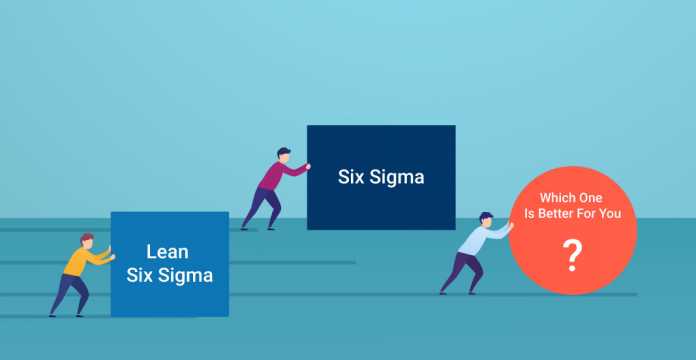
Today, enterprises depend on proven business tools and methods in order to modify to satisfy the requirements and demands of consumers globally. Six Sigma is no exception, as multiple branches, systems, and schools of thought have developed from the initial concept over the years to fit current needs. Lean and Six Sigma are two separate schools of thought that have consolidated into a single, cohesive methodology that can spout multiple purposes, known as Lean Six Sigma.
This is a mixture of management systems that build on the principles of Six Sigma with a center on performance. Both programs aim to accomplish the same thing: more efficient processes that yield a more significant bottom line. However, the variation comes in the way they go on reaching that goal.
In this article on Six Sigma vs Lean Six Sigma, we will discuss the differences between each concept and which type of company will benefit from which of these methodologies.
An Introduction to Six Sigma
Six Sigma was formed with a particular objective, which is to reduce variation and check performance rates in production processes through mathematical/statistical study. To do this, Six Sigma practices one of two, 5-step methods – either the DMAIC or the DMADV method.
Both approaches have their different techniques. DMAIC is for Define, Measure, Analyze, Improve, and Control. This method includes identifying the difficulties, taking stock of your current plans, classifying and executing a solution, and maintaining that solution in the prospect. This is ideally suited for supply chain performance problems or when only changes to the process are required, not an entirely new function.
That’s where DMADV, which stands for Define, Measure, Analyze, Design, Verify comes in. The first stages of the project are the same, but the Design stage allows for the making of an entirely different tool to solve the query. The Verify phase then concentrates on ensuring that the new solution does, in fact, extend to solve the problem.
Six Sigma essentially assumes control of preventing supply chain mistakes, identifying problems, and solving them as efficiently as possible.
An Introduction to Lean Six Sigma
The Lean method, on the opposite hand, is wholly converged on reducing waste, providing the most value to clients with the lowest possible price of the investment. The term Lean was initially applied to describe the Toyota Business System in the 1980s, a business theory that encouraged the company to run at maximum efficiency. It involves every layer of an organization, helping pattern new processes and drive the allocation of resources. The primary difference between Lean and Six Sigma is that Lean is less concentrated on manufacturing, but usually shapes every aspect of a business.
Lean Six Sigma links these two approaches, which produces a powerful toolkit for directing waste reduction. As companies try to understand where they may have destructive practices in place, the DMAIC process provides an outstanding road map for identifying and solving the difficulties they confront. This synergy between methodologies helps eliminate the 8 kinds of waste, removing anything from a method – whether its material, time, or effort – doesn’t add meaning. The forms of waste are:
- Defects – Products that don’t satisfy quality criteria
- Overproduction – Excelling demand or producing more than was required
- Waiting – Process bottle-necks and downtime
- Non-Utilized Talent – Badly using or misallocating human resources
- Transportation – Careless shipping arrangements
- Inventory – Holding on to a plethora of products or raw material
- Motion – Random moving of product, material, or people
- Extra Processing – Putting more effort than required
The Difference Between Lean Six Sigma and Six Sigma
Lean Six Sigma is a classic fit for companies attending to streamline their methods and offer as much benefit to the customer as possible. The phased study and clear roadmap presented by the DMAIC process can be essential when used to any business problem, not just defect bars as in traditional Six Sigma methodology.
As the conversation between Lean and Six Sigma remains a blur, totally new methods, and different opinions are bound to arise. Specialists that can help organizations manage these complex clarifications will define the next significant change in Six Sigma thinking.
Conclusion
Over the years, many methodologies have appeared, but only a few of them have continued to showcase their importance in organizations worldwide. The power of LEAN and Six Sigma is based on their quality culture foundation. Both these methodologies have outlined roles and duties & a particular mindset.
In a nutshell, Six Sigma is a problem-solving methodology, which concentrates on the refinement of variability. It uses human assets, data, analyses, and statistics to eliminate waste & defects while improving customer comfort, profit, & customer value. Whereas, Lean is defined as a set of waste identification & elimination process, which is based on the Toyota Production System policies revolving around the reduction of waste while building value from the customer’s point of view.
LEAN and Six Sigma methodologies are equal and can be performed in parallel; if executed correctly. I hope this article on Six Sigma vs Lean Six Sigma, helped you to make a better choice.
To learn more about these methodologies, individuals and enterprise teams need to get trained in popular quality management certification courses like Lean Six Sigma or Six Sigma today!
Some of the popular Quality Management Certification Courses that individuals and enterprise teams can take up are:














